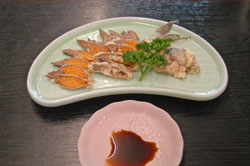If you know anything about heart disease epidemiology, you know that Japan has the lowest rate of heart disease in the world. The usual explanation is high fish consumption. But other countries, such as Norway, also eat a lot of fish but don’t have low heart disease rates.
My visits to Japan suggest to me that Japanese eat far more fermented foods than people in other countries, including Norwegians. If heart disease is due to infection, then it’s clear that the immune stimulation provided by fermented foods helps fight infection. My umami hypothesis — that we like umami, sour, and complex flavors to encourage bacteria consumption, which we need to be healthy — began with a trip to Japan in 2008, when I noticed, in a food court, many types of miso for sale. Back in Berkeley, I started making miso soup. I was stunned how well it worked. All you needed was miso. No other flavorings. It was so easy and good I ate it every day. It was my first bit of evidence that fermented foods are different and better than other foods.
Here are some fermented foods that are easy to get in Japan:
1. Miso soup. Most Japanese eat this daily. In a few countries, such as France, many people eat yogurt daily. Koreans eat kimchi daily. In most countries, as far as I know, it’s hard to find a fermented food (apart from cheese and alcoholic drinks) that’s eaten daily by most people. Miso is also used to flavor fish.
2. Japanese pickles. The best pickles in the world. Some are pickled as long as as two years, developing noticeable alcohol. Other countries have pickles, of course, but as far as I know the only pickle restaurants are in Japan. Moreover there are pickle shops in big Japanese cities. The only other pickle shops I’ve seen are in New York City.
3. Pickled apricots (umeboshi). At a food court you have a choice of acidity, anywhere from 5% (slightly sour) to 25% (extremely sour).
4. Vinegar drinks. Tokyo 7-Elevens sell a black vinegar drink. Vinegar and water. In food courts you can buy special vinegars for this purpose. I’ve never seen vinegar drinks for sale anywhere else.
5. Natto.
6. Yogurt. The Japanese yogurts I’ve tried were sweetened but weren’t as sweet as the yogurts sold in Beijing.
7. Yakult. The fermented milk drink. It’s sold in such small packages it’s pretty clear it must appeal to people who think it improves their health. It doesn’t boost energy, quench thirst, or taste especially good. The manufacturer says it is good for health and that one bottle per day is all you need.
8. Beer and wine.
Because soy sauce is used in small amounts, it doesn’t count. At a Tokyo restaurant I met a nurse who said she thought you should eat fermented foods every day to be healthy. She said perhaps a third of Japanese believe this.
I’ve never seen high Japanese consumption of fermented foods noticed by epidemiologists. Individual fermented foods (such as miso), yes; the whole category, no. You can see how hard it would be to combine across foods: how much miso equals how much Yakult? Yet I’m sure fermented food consumption is extremely healthy.
